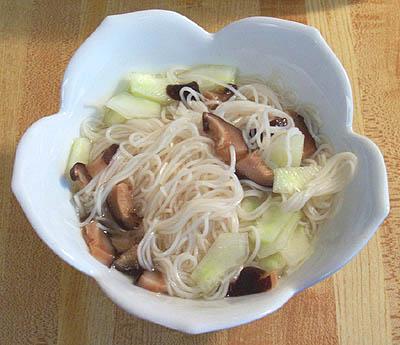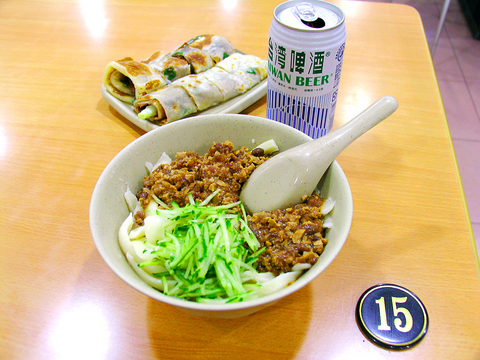Re: Whats your Favourite Asian Food?
A brief on Phở
This is an attempt by non-Vietnamese to describe (briefly) the history of Phở, and a few popular regional varieties. Apologies for any inaccuracies.
To summarize history, prior to arrival of the French, Vietnam was like many of her Asian neighbors, refraining from consumption of beef. The family cow spent most of its life laboring in the rice paddies, it was just immoral to kill it for meat. Then the French came and Moo-Moo's became fillet mignon and pot-au-feu. End of history lesson.
The Vietnamese wasted no time in adopting to French tastes of beef. The first phở bò, or beef noodle is reported to have been served between late 1800's to early 1900's, in the provicne of Nam Dinh, just SW of Hanoi. The dish quickly spread to Hanoi, then to other cities. Phở bò was served with clear beef bone soup base, with banh pho, a white rice noodle. If you could afford it (back then), your bowl came with slices of beef, or various beef bits and parts (tendon, tripe, oxtail, etc).

Generally speaking Phở is considered a northern Vietnamese dish (Pho Bac = Northern Pho), with some Chinese and French influences. Purists prefer to eat it without a lot of garnish or sauce, because they consider the soup base to be most important, and should NOT be contaminated in flavor by adding lime juice, hoisin, or chili sauce directly into the bowl. Purists don't even like bean sprouts. If you see a plate of onions on the side, put some chili sauce on it and eat it with a spoon (along with some soup), but don't put it inside your bowl.
During the mid 20th century, Vietnam was divided between North and South via 1954 Geneva Conference. An estimated 2 million North Vietnamese moved South, increasing the popularity of Phở in Southern Vietnam. The South Vietnamese added their own preferred garnish, such as bean sprouts, cilantro, basil, lime, hosin sauce, etc.
Over time, various other ingredients are added, such as beef balls, seafood, chicken, etc. My favorite variety is chicken, which is made with clear chicken soup base (no beef bones):
Now let's briefly go over the 3 main regions of Vietnam, and their local Phở varieties. Wikipedia also has a good write-up:
Northern Vietnam
Phở bò (beef noodle), which we've already covered. Bun, a thin rice vermicelli, typically served in dishes like Bún Cha (with grilled pork), and Bún Than, which is a chicken noodle soup.
Bún Cha, note the rice vermicelli is served "dry" on a plate. You can read more about it
.
Bún Than (chicken noodle soup), in this picture the soup hasn't been added:
Central Vietnam
Central Vietnam is famous for their Bún Bò Huế, which is served with pork-beef-lemon grass soup base, and bun noodles (roundish rice noodles). In addition to the beef, be warned that this dish may come with pig's feet, pig's blood cubes, and other goodies like steamed pork and shrimp paste. The spicy lemon grass soup WILL STAIN if you get it on your shirt. You can read more about it
. There's a few restaurants in Westminster that serves Central Vietnamese dishes, I'll post them later in this thread.
Two versions of Bún Bò Huế, note the noodle looks different from typical northern Phở:
Other Central Vietnam dishes include Mì Quảng, from Quang Nam province. The traditional style use a yellow-ish noodle, but these days I've seen it served with white noodles. You can read more about it
.
And there's Bún măng Vit, which is served with bamboo (măng) shoots and duck: (quack quack)
Southern Vietnam
As mentioned earlier, the South Vietnamese adopted their own styles of garnish to Phở. In addition, they have local noodle styles, as well as those influenced by Chinese immigrants, Thai-Khmer (Cambodian), and possibly Chăm.
After the Manchu conquest of Ming Dynasty, many ethnic Chinese immigrated from Guangdong to Vietnam. About 85% of them lived in the south in 1970's, and are referred to as "Hoa". They typically spoke Cantonese or Teochew. These Chinese immigrants also brought with them Southern style Chinese noodles to Vietnam, typically referred to as "mi" in Vietnamese, as well as flat/wide Chinese noodles for pan frying, and clear noodles used in Hu Tieu Thanh Xuan and Hu Tieu Mi Kho. But the Vietnamese "Bún" noodle is totally indigenous.
Here's a picture of Hu Tieu Mi Kho, made with clear noodle (aka "glass noodle) and egg noodles. Typically clear noodles are served with seafood, but can also be found with beef/pork or combination with seafood:
"Glass Noodles":
Crunchy Chinese egg noodles (mi):
Here's another Southern dish, Bún riêu (crab meat noodle soup). This version is topped wtih crab and shrimp paste:
Bun Thit Nuong, rice noodles with pork and veggies -- Recipe
. This dish is served with cold vermicelli noodle, sometimes with sliced marinated cucumber, daikon, carrot, with veggies and sprouts added, and toped with marinated pork and served with fish sauce on the side. In the photo below, some of the veggies went into the sauce. @_@
Bun cha gio, or noodle with fried egg rolls (cha gio = fried eggrolls). This dish is usually served with cold vermicelli on bottom, topped with veggies and cut fried eggroll, with fish sauce on the side:
Here's a Southern dish with some Chinese & Khmer (Cambodian) influence, Hu Tieu Nam Vang, aka Phnom Penh Noodle Soup (recipe
). This dish could be made with a variety of different noodles, but the soup is pork bone based and not beef or fish. Go here for more info:
Here's another variety of Hu Tieu noodles, Hu Tieu My Tho. My Tho is a city about 70 km SW of Saigon. This dish is made with pork bone soup stock, ground pork, pork bone/ribs/knuckle, clear, roundish medium chewy noodle, and somewhat fatty:










































